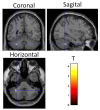Simultaneous fMRI and tDCS for Enhancing Training of Flight Tasks
- PMID: 37508957
- PMCID: PMC10377527
- DOI: 10.3390/brainsci13071024
Simultaneous fMRI and tDCS for Enhancing Training of Flight Tasks
Abstract
There is a gap in our understanding of how best to apply transcranial direct-current stimulation (tDCS) to enhance learning in complex, realistic, and multifocus tasks such as aviation. Our goal is to assess the effects of tDCS and feedback training on task performance, brain activity, and connectivity using functional magnetic resonance imaging (fMRI). Experienced glider pilots were recruited to perform a one-day, three-run flight-simulator task involving varying difficulty conditions and a secondary auditory task, mimicking real flight requirements. The stimulation group (versus sham) received 1.5 mA high-definition HD-tDCS to the right dorsolateral prefrontal cortex (DLPFC) for 30 min during the training. Whole-brain fMRI was collected before, during, and after stimulation. Active stimulation improved piloting performance both during and post-training, particularly in novice pilots. The fMRI revealed a number of tDCS-induced effects on brain activation, including an increase in the left cerebellum and bilateral basal ganglia for the most difficult conditions, an increase in DLPFC activation and connectivity to the cerebellum during stimulation, and an inhibition in the secondary task-related auditory cortex and Broca's area. Here, we show that stimulation increases activity and connectivity in flight-related brain areas, particularly in novices, and increases the brain's ability to focus on flying and ignore distractors. These findings can guide applied neurostimulation in real pilot training to enhance skill acquisition and can be applied widely in other complex perceptual-motor real-world tasks.
Keywords: HD-tDCS; aviation; basal ganglia; brain connectivity; cerebellum; dorsolateral prefrontal cortex; fMRI; neuroergonomics; neurostimulation; training.
Conflict of interest statement
The authors declare no conflict of interest.
Figures







Similar articles
-
Neuromodulation on the ground and in the clouds: a mini review of transcranial direct current stimulation for altering performance in interactive driving and flight simulators.Front Psychol. 2024 Nov 28;15:1479887. doi: 10.3389/fpsyg.2024.1479887. eCollection 2024. Front Psychol. 2024. PMID: 39669679 Free PMC article. Review.
-
Transcranial Direct Current Stimulation Modulates Neuronal Activity and Learning in Pilot Training.Front Hum Neurosci. 2016 Feb 9;10:34. doi: 10.3389/fnhum.2016.00034. eCollection 2016. Front Hum Neurosci. 2016. PMID: 26903841 Free PMC article.
-
Beneficial effects of cerebellar tDCS on motor learning are associated with altered putamen-cerebellar connectivity: A simultaneous tDCS-fMRI study.Neuroimage. 2020 Dec;223:117363. doi: 10.1016/j.neuroimage.2020.117363. Epub 2020 Sep 9. Neuroimage. 2020. PMID: 32919057
-
Complex sequential learning is not facilitated by transcranial direct current stimulation over DLPFC or M1.Eur J Neurosci. 2024 Apr;59(8):2046-2058. doi: 10.1111/ejn.16255. Epub 2024 Jan 25. Eur J Neurosci. 2024. PMID: 38270331
-
Neuroimaging and neuromodulation approaches to study eating behavior and prevent and treat eating disorders and obesity.Neuroimage Clin. 2015 Mar 24;8:1-31. doi: 10.1016/j.nicl.2015.03.016. eCollection 2015. Neuroimage Clin. 2015. PMID: 26110109 Free PMC article. Review.
Cited by
-
Promising applications of non-invasive brain stimulation on military cognition enhancement: a long way to go.Gen Psychiatr. 2023 Oct 29;36(5):e101264. doi: 10.1136/gpsych-2023-101264. eCollection 2023. Gen Psychiatr. 2023. PMID: 37920407 Free PMC article. No abstract available.
-
A study of dynamic functional connectivity changes in flight trainees based on a triple network model.Sci Rep. 2025 Mar 6;15(1):7828. doi: 10.1038/s41598-025-89023-y. Sci Rep. 2025. PMID: 40050304 Free PMC article.
-
Lattice layout and optimizer effect analysis for generating optimal transcranial electrical stimulation (tES) montages through the metaheuristic L1L1 method.Front Hum Neurosci. 2024 Feb 29;18:1201574. doi: 10.3389/fnhum.2024.1201574. eCollection 2024. Front Hum Neurosci. 2024. PMID: 38487104 Free PMC article.
-
Investigating visual perception abilities in flight cadets: the crucial role of the lingual gyrus and precuneus.Front Neurosci. 2025 Feb 26;19:1519870. doi: 10.3389/fnins.2025.1519870. eCollection 2025. Front Neurosci. 2025. PMID: 40078710 Free PMC article.
-
Neuromodulation on the ground and in the clouds: a mini review of transcranial direct current stimulation for altering performance in interactive driving and flight simulators.Front Psychol. 2024 Nov 28;15:1479887. doi: 10.3389/fpsyg.2024.1479887. eCollection 2024. Front Psychol. 2024. PMID: 39669679 Free PMC article. Review.
References
-
- Federal Aviation Administration, United States Department of Transportation Hourly Requirements. [(accessed on 9 June 2023)]; Available online: https://www.faa.gov/faq.
-
- American College of Surgeons How Many Years of Postgraduate Training Do Surgical Residents Undergo? [(accessed on 9 June 2023)]. Available online: https://www.facs.org/for-medical-professionals/education.
-
- Murray G., Green J. After COVID-19, Aviation Faces A Pilot Shortage. [(accessed on 9 June 2023)]. Available online: https://www.oliverwyman.com/our-expertise/insights/2021/mar/after-covid-....
-
- Robeznieks A. Doctor Shortages Are Here—And They’ll Get Worse if We Don’t Act Fast. [(accessed on 9 June 2023)]. Available online: https://www.ama-assn.org/practice-management/sustainability/doctor-short....
-
- International Civil Aviation Organization Multi-Pronged Approach to Enhancing Pilot Training and Competency During a Period of Anticipated Growth and Complexity; A40-WP/122; 2/8/2019. 2019. [(accessed on 9 June 2023)]. Available online: https://www.icao.int/Meetings/a40/Documents/WP/wp_122_en.pdf.
Grants and funding
LinkOut - more resources
Full Text Sources
Miscellaneous

